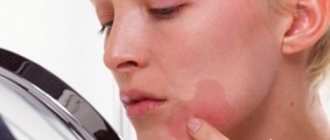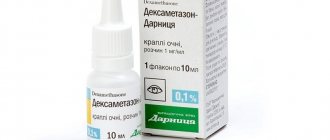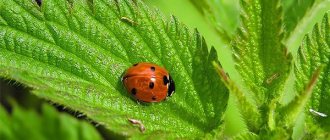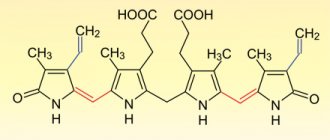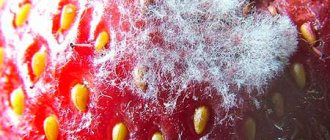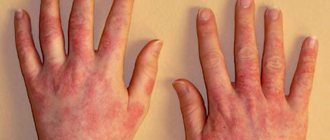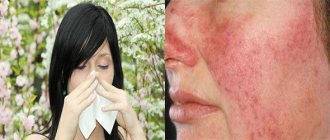Why does allergic irritation occur from the patch on the skin?
Allergic irritation from adhesive tape most often occurs for two main reasons:
- under the influence of the adhesive composition of the patch and its components;
- under the influence of a medicinal composition impregnating the adhesive plaster or its component.
Since in the process of producing patches different companies and manufacturers use different technologies, medicinal and adhesive compositions, most often an allergic reaction develops to products from one particular company. The following may increase the likelihood of developing a hypersensitivity reaction:
- long-term wearing of the patch without changing (more than 24 hours);
- high level of humidity;
- high air temperature;
- poor oxygen access.
More often, an allergy to the patch occurs in people prone to allergic diseases or suffering from eczema, atopic dermatitis and other skin pathologies of allergic etiology.
All patches used in medicine are divided into several large groups, depending on their purpose and medicinal composition. The reasons for the formation of allergic symptoms from the use of different types of patches will also differ. Conventionally, the patch is distinguished:
- Medical. At the same time, allergic irritation from the patch in rolls occurs under the influence of adhesive substances. An allergy from the use of a medical patch with a pad is formed in response to the effect on the skin of the medicinal substance with which the pad is impregnated. The level of allergenicity of the patch depends on the manufacturing conditions, materials used and production technologies. As a rule, the worse the manufacturing performance, the lower the cost of the product. Therefore, using patches that are too cheap can be dangerous, as they can cause contact or atopic dermatitis.
- Pepper. An allergy from the use of this type of patch is formed in response to skin contact with the pungent substances of pepper. Even a person who calmly consumes the spice in food can develop intolerance to the pepper patch. The main reasons for the formation of hypersensitivity in this case are poor air intake and too high a concentration of pepper. Very often, a burn from a pepper patch is confused with an allergic skin reaction. However, irritation and redness of the epithelium from baking substances is a normal reaction of the body.
- Transdermal. Transdermal is a patch impregnated with a medicinal substance, during the wearing of which this substance quickly penetrates into the soft tissues and into the bloodstream, providing a targeted therapeutic effect. Most often, transdermal patches impregnated with an anesthetic substance (Voltaren, Olfen, Diclobene, Nanoplast, Diclofenac) or patches that can reduce the craving for smoking (Nicorette) are used. The causes of allergies from the use of this type of patch can be: the composition of the adhesive base, medicinal components, use of the patch on wound surfaces, non-compliance with the instructions for use of the drug.
- Postoperative. A hypoallergenic patch after surgery can also cause allergies. In operating surgery, patches are used to secure bandages at surgical sites (incision and suture areas). An allergy to the patch after surgery occurs against the background of a decrease in the immunological reactivity of the immune system at the site of the incision and an increase in the level of sensitivity to various substances.
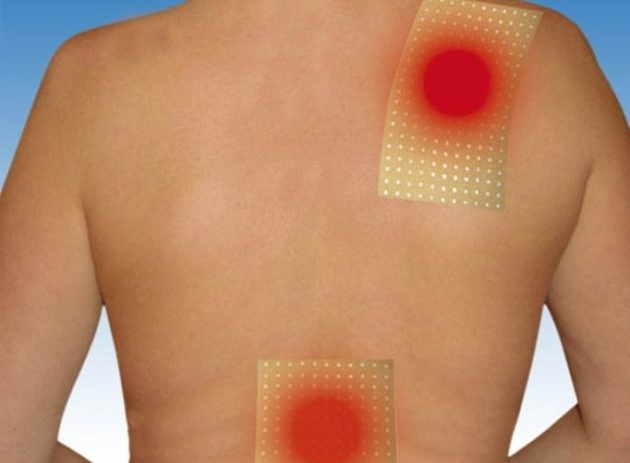
Pepper patch may cause skin burns
What is pepper spray and how does it work?
Pepper spray is an aerosol that contains a chemical compound that irritates the eyes, causing tearing, burning, pain and temporary blindness when sprayed towards the face. The tear agent is used in policing, riot control and self-defense, including defense against wild animals. The effect of the spray on the enemy allows the person in danger to escape, and the police officer to effectively restrain the criminal.
The active ingredient in pepper spray is capsaicin, a chemical derived from the fruit of the cayenne pepper plant, including chili peppers. Capsaicin is extracted from capsicums using an organic solvent such as ethanol. The solvent is then evaporated, and the remaining wax-like resin is oleoresin capsicum (OC), an extract of hot pepper.
Pepper sprays can contain from 0.18 to 3% active ingredient. However, a high percentage of the main ingredient is not always an indicator of potency, since it is not known whether the quality of pepper oil used was high or low. There are six types of capsaicinoids of varying quality. Manufacturers do not specify one variety or another on their products. The most common in everyday use are cans containing from 1.3 to 2% of the active substance.
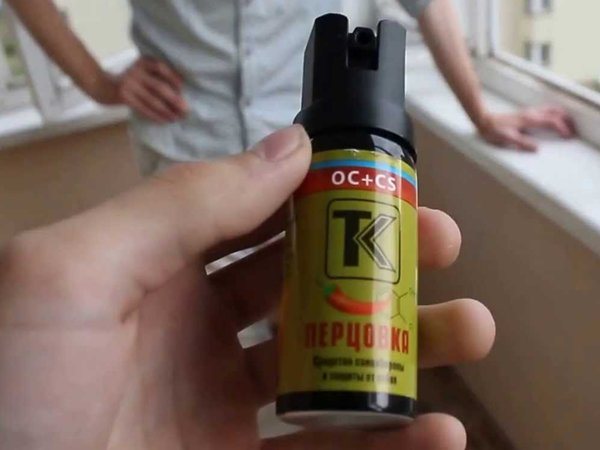
Mechanisms of development of an allergic reaction from the use of a patch
The formation of an allergic hypersensitivity reaction from the use of the patch occurs due to the presence in the body of immune formations sensitive to the components of the patch - class T leukocytes. These leukocytes, interacting with the allergen - the substance that causes the allergy, form an antigen-antibody complex. The complex interacts with the body’s mast cells, causes their activation and release of seratonin, histamine and inflammatory mediators into the bloodstream - substances that cause allergic symptoms.
The formation of signs of allergy after the first contact with the allergen does not occur. First, sensitivity is formed - sensitive T-leukocytes are produced. Allergic symptoms occur after the allergen re-enters the body.
However, the severity of allergic manifestations can vary greatly depending on the level of sensitivity of the body, the amount of allergen, the time of its exposure, and the state of the immune system. It is customary to distinguish the following degrees of an allergic reaction from the use of a patch:
- Light. It looks like slight redness at the site of contact of the patch with the skin, is accompanied by slight itching, and is easy to self-medicate.
- Average. It is characterized by the spread of redness beyond the point of contact of the skin with the patch, the formation of urticaria and an intense feeling of itching and burning. Requires medical intervention in therapy.
- Heavy. It is characterized by the appearance of ulcers and blisters on the epithelium, severe hyperemia and swelling, and intense burning. May be accompanied by a general deterioration in health, an increase in body temperature. Requires first aid and mandatory medical intervention.
Symptoms of the disease
As a rule, allergic reactions to the use of a simple medical patch are observed directly at the site of contact with the skin.
- Locally, mild hyperemia and itching are observed. This symptom goes away on its own within 2-4 days;
- in more severe cases, peeling of the skin and itching of the skin at the location of the adhesive plaster is observed. In addition, there may be a fine blistering rash that may burst and form eczematous ulcers on the skin;
- General symptoms, characterized by excessive lacrimation, frequent sneezing, and allergic rhinitis, also indicate the development of allergies;

redness is observed in various parts of the body, and not just at the place where the patch is applied; An allergy to pepper-impregnated adhesive plaster can be complicated by severe dermatitis, breathing difficulties and swelling. As a result, the development of Quincke's edema is possible, and in case of predisposition to allergic manifestations, anaphylactic shock may develop
These two conditions require immediate medical attention; Particular attention should be paid when an allergy to the patch develops in a young child. Due to circumstances, the baby cannot control the unbearable itching and scratches the blisters until blood appears
This creates a certain danger, since the open wound surface is an entry point for the development of infections. Such symptoms are possible with moderate and severe allergies, when blisters can even open on their own. Under no circumstances should pepper patch be used to treat children;

Often allergic symptoms can increase with each subsequent use of the adhesive plaster. Therefore, you should not neglect the first negative manifestations of the skin in the form of mild itching and redness.
If at least one of the above symptoms appears, specific treatment should be carried out in order to promptly limit the intake of allergens into the body. In case of negative manifestations using a pepper patch, it is necessary to immediately remove it and remove any remaining allergen.
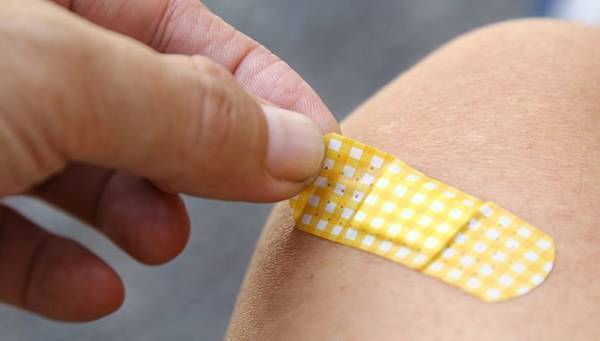
In cases where drug treatment is required to neutralize negative symptoms, it must be performed directly under the supervision of the attending physician.
How is a patch allergy diagnosed?
If during the use of an adhesive plaster, at the site of its direct contact with the skin, the formation of skin allergic symptoms occurs, we can talk about the presence of an allergy to the adhesive plaster. To confirm or refute your concerns, as well as prescribe treatment if necessary, you must consult a dermatologist.
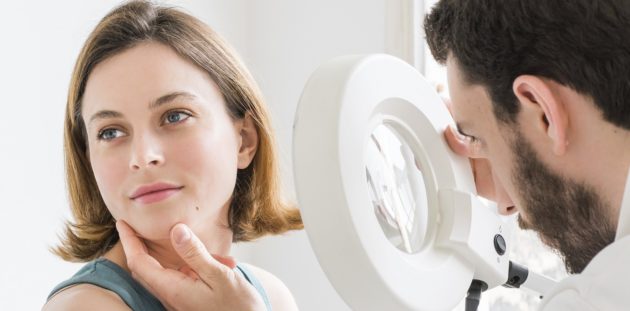
To make a diagnosis, a specialist will need to conduct an examination and collect an anamnesis. In order to identify the allergen, it will be necessary to undergo some laboratory tests: a blood test for the level of leukocytes, provocative tests, prick tests or blood sampling for allergy tests. All this will help not only establish the fact of an allergic reaction, but also accurately differentiate the substance that caused it.
Hot pepper burn
This situation is not new. Anyone who carelessly handles this vegetable can get burned by hot pepper. The alkaloid, which is the main component of pepper, strongly irritates not only the skin, but also the mucous membranes. Contact of even a small amount of pepper on exposed skin will result in severe burns. Appropriate measures must be taken quickly to resolve the problem.
First aid
First of all, you should give up the desire to wash the burn with water or use soap to eliminate the burning sensation. This will not help in any way, but will only make the situation worse. First aid must be correct. Experts say that the right remedy for this situation is a vinegar solution. Dilute the vinegar essence with water and gently wipe the affected area. Vinegar slightly absorbs alkaloids and relieves burning sensation. A similar procedure can be done with lemon juice. And then medications should come to the rescue.
Drug treatment
There is no way to do without it. Therefore, it is always worth having the most optimal means on hand. Drug treatment consists of Panthenol spray, which must be carefully distributed over the skin. This will not only prevent further spread of alkaloids, but will also eliminate the burning sensation.
Pantoderm cream has also proven itself well. It relieves pain and redness, helps relieve severe burning and prevents spread to other areas of the skin. Drug treatment with its help should be carried out for at least 3 days.
Home Remedies
The arsenal of a home first aid kit is wide. There are many available tools to help quickly cope with a burn. Home remedies worth taking are:
- Milk or fermented milk products to wipe the affected area.
- Soda solution. Dissolve one teaspoon of baking soda in 100 milligrams of water. Apply a lotion to the affected area.
- Kefir, milk, ice cream are good for burns of the oral mucosa. A glass of liquid product or 150 grams of ice cream will reduce the burning sensation by an order of magnitude.
- Boiled rice or potatoes, if pepper particles get on the mucous membranes of the mouth, also help a lot.
- Apply a piece of peeled fresh potato to the affected area.
Home remedies are simple and effective and almost everyone has them on hand.
First aid
In the event that while wearing any type of patch you feel itching and burning, and the area of contact with it becomes covered in a rash or turns red, you must:
- Remove the patch from the skin.
- Thoroughly rinse the area of skin that came into contact with the patch with clean distilled or boiled water.
- Treat the skin area with any available antiseptic: Furacilin solution, alcohol or vodka.
- Use an ointment or cream with an anti-inflammatory effect.
- Take an antihistamine. In cases of a rapid and extensive allergic reaction, it is better to use an antihistamine in the form of an intramuscular injection. Next, they begin to treat allergic irritation from using an adhesive plaster.
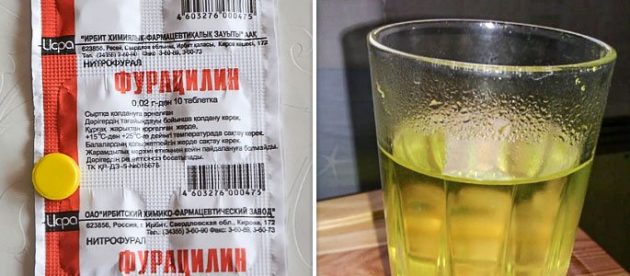
conclusions
Pepper spray is extremely unpleasant, but tolerable. As soon as the substance gets on the body, you will immediately experience a burning sensation, pain, tears, remember profanity and other “delights”. Don't forget the rules! Do not rub the contact area with your hands or clothing. Try to call for help immediately. Take out a handkerchief or dry napkin, and then use tangential movements without smearing to remove tears.
What to wash off with? Milk and baking soda solution. A small amount of water is dangerous for the face (including puddles and snow), remember! If you find a pharmacy nearby, go there for drops, and the pharmacists will not refuse to help. Once you get rid of acute symptoms, go to the clinic. It is impossible to determine the composition and type of canister used, so it is better to consult a doctor.
If you're really scared, wear a motorcycle helmet. Impractical, but the protection is 100%, and people around you will think that you have a cool bike. Don't push against the wind!
Being sprayed in the eyes with pepper spray is extremely unpleasant and, for some, life-threatening. In such a situation, it is important not to cause harm yourself. By studying the rules for neutralizing aerosols, you can avoid serious negative reactions to the body. It is important to remember that rinsing your eyes and face with water is prohibited, because its effect on certain gas compounds will only worsen the condition.
How to treat an allergy to adhesive plaster?
How to treat an allergy from a patch? How to treat an allergy to a patch? Irritation from the patch, what to apply? These are the most common questions that arise when an allergic reaction occurs at the site of use of the adhesive plaster.
Once a diagnosis is made, treatment for an allergy from adhesive plaster is based on preventing repeated contact of the identified allergen with the skin and the use of medications that can reduce the intensity of skin allergic manifestations. There is no single treatment regimen, but there are general recommendations that are effective in all cases of an allergic reaction to adhesive plaster.
The therapy process itself involves the use of medicines and traditional medicine recipes.
Allergic irritation from adhesive plaster treatment with drugs:
- Local antihistamines (Fenistil, La-Cri, Psilo-Balm, Gistan). They relieve itching and burning, eliminate swelling, redness, and rash.
- Antihistamines for oral use. Tablets (Diazolin, Suprastin, Tavegil, Cetrin, Ketotifen. Cetirizine, Agistam, Fenkarol, Aleron, Lorano, Eden, Erius, Claritin, Loratadine, Desloratadine, Zodak), drops (Zodak, Fenistil, Cetrin, Cetirizine) and syrups (L- Cetus, Claritin, Eden, Erius).
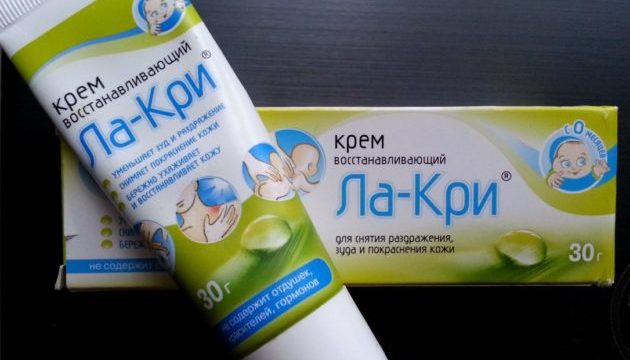
- Antihistamines in the form of injections for intramuscular administration (Suprastin, Tavegil).
- Wound healing and moisturizing agents: Bepanten, Panthenol, Lanolin, Dexpanthenol, D-Panthenol.
- Antibacterial agents (Gentamicin ointment, Erythromycin ointment, Levomekol, Oflocain, Vundekhil, Miramistin).
- Glucocorticosteroids in the form of tablets (Prednisolone), intramuscular injections (Betamethasone, Prednisolone, Diprospan), ointments, creams and gels (Akriderm, Betamethasone, Hydrocortisone, Prednisolone, Sinoflan, Advantan, Elokom, Belosalik, Celestoderm, Lorinden). These drugs are used in cases where there is no therapeutic effect from the use of other medications. Glucocorticosteroids are characterized by rapid action and a high degree of effectiveness. However, they have a number of side effects and contraindications and can lead to addiction and withdrawal symptoms. When using them, they require strict adherence to the instructions and dosage regimen.
Allergy to the patch, treatment with traditional recipes includes the use of:
- rubbing based on bay leaf decoction;
- compress from dill branches;
- compress based on plantain leaf;
- decoction of string for oral administration;
- compress based on green tea and chamomile.
Before using any drug or traditional recipe, you should consult with your doctor, since self-medication may not only be ineffective, but also dangerous.
Eye burn from pepper spray
The mucous membrane of the eye is very delicate. Therefore, having received an eye burn from pepper spray, it is necessary to respond urgently in order to prevent significant deterioration of vision.
Consequences of use
Pepper spray simultaneously affects the senses of touch and smell. The consequences of application are as follows:
- Severe burning and redness of the eyes.
- Contraction of the muscles of one or both eyes. Inability to open them completely.
- Increased lacrimation.
The respiratory organs in this case also suffer greatly. If a large amount of the contents of the can enters the respiratory tract, even pulmonary edema may occur. In addition, sneezing, burning, itching, and runny nose are observed. The consequences of use are very serious. In some cases, a person may even suffocate.
Immediate help
Here you need to react instantly. Immediate assistance is as follows:
- Make some kind of blotting of the places where the pepper spray came into contact. Rubbing is strictly prohibited, as the situation will worsen.
- Induce lacrimation by blinking frequently.
- Drops with diclofenac.
- "Albucid" in the form of instillation and for washing the eyes.
- Eye drops containing Ledocaine. It is important that they can be instilled no more than twice. Otherwise, you may experience significant visual impairment.
- "Vizin" is practically ineffective, since it provides only minor rinsing. But if nothing else is at hand, then it will help a little.
In any case, an eye burn requires contacting a specialist who can carry out all the procedures and preserve vision. An ophthalmologist knows very well how to deal with such a situation and not lose vision.
Folk remedies for chemical eye burns
They are not new, since the components that neutralize burns are the same everywhere.
- Rinse eyes with full-fat milk.
- Make lotions from a soda solution and rinse your eyes with a weak soda solution.
Folk remedies for chemical eye burns are almost always at hand and they help quite well, but you can’t cope without an ophthalmologist.
Prevention measures
To prevent an allergic reaction to the adhesive plaster, it is recommended:
- use a hypoallergenic perforated patch;
- for a timely response, use a transparent adhesive plaster (so you can notice changes on the skin in time)4
- regularly change the patch and change the location of the patch on the skin;
- do not wet or heat the place where the patch is attached;
- use a patch if necessary (it is better not to cover small scratches and wounds; it is enough to treat them regularly);
- strictly follow the instructions for using the pepper or transdermal patch.
Precautionary measures
To avoid negative side effects, you should consult your doctor before starting therapy. Before use you must:
- carefully read the instructions for use;
- make sure the packaging is intact:
- check the expiration date;
- study the composition of the medicine;
- hair, cut with scissors;
- use immediately after opening and removing the adhesive film.
The application can only be done on healthy skin. There should be no mechanical damage, rashes, purulent wounds, or irritation. After gluing, hands must be thoroughly washed with soap and water several times.
After use, the sheet must be folded with the sticky part inward, packaged in a bag, sealed or tied, and thrown into the trash bag. It cannot be reused.
How to conduct a preliminary sensitivity test?
Before using the patch, you must conduct an allergy test. To do this, it will be enough to stick a small piece of it on the wrist area and wait 20-40 minutes. After time has passed, remove the adhesive plaster and assess the condition of the skin.

If the epithelium is red, covered in rashes, itchy or itchy, we can talk about the presence of an allergy. In this case, the patch cannot be used. If no changes are observed on the skin, feel free to use the product, it is safe for you.
What is it and the purpose of use
The cans labeled OS (Oleoresin Capsicum) contain a mixture of essential oils, fatty acids and resins from various varieties of hot red pepper (the contents are called irritant).
The permissible maximum content of the active substance is not more than 1000 mg. Oleoresin capsicum, as the name of this mixture sounds in Russian, is popularly called pepper.
The peculiarity of the use of this remedy is the damage and severe irritation of the mucous membrane of the upper respiratory tract. It can be effectively used both to repel a human attack and to repel aggressive animals, in particular dogs.
The undoubted advantage is that when using it, you do not have to worry about whether the attacker is under the influence of drugs or alcohol.
The use of pepper spray, by definition, cannot cause harm to a person or animal that would be life-threatening, but at the same time it allows you to reduce the level of aggression and use the resulting advantage in time to leave the scene of the aggressor’s attack. That is, pepper spray is the ideal tool to protect yourself and gain time.
Back applicators
For pain syndromes in the back area, modern pharmacy offers a variety of products with an analgesic effect to choose from. One of them is Versatis, with the active ingredient lidocaine. This drug has proven itself in many branches of medicine for pain relief.
When applied, only 3 percent of the substance enters the general bloodstream, the rest of it acts locally. Lidocaine can pass into breast milk through the placenta. Therefore, it is better not to use it in pregnant women and nursing mothers.
Its effectiveness is often discussed on forums. The main message is the effectiveness of its use: “when you’re bent over, but it’s impossible to straighten up.”
Use for cancer pain
Relieving suffering in patients with cancer is one of the leading tasks in cases where it is impossible to cure this disease. To relieve pain, various types of analgesics without narcotic substances are used. If the condition worsens, narcotic drugs are included in the treatment regimen. Often all efforts remain in vain.
The complexity of drug use is as follows:
- they must be administered to the patient before the previous dose is still effective;
- the need to gradually increase the dose;
- negative effect on the liver;
- high doses depress the centers of the brain, and therefore the patient’s breathing worsens;
- gradual drug damage to the nerve cells of the brain.
In this case, local use of narcotic drugs is indicated. For this purpose, fentanyl is used as the active ingredient.
The drug is released gradually over 72 hours from the moment of contact with the human body. It is most effective after 12 hours from the time of application. The attending physician selects the dose individually, based on the patient’s condition, age, and weight.
In the pharmacy chain you can buy such a product called Durogesic. However, it should be used with caution by people suffering from:
- liver diseases;
- in case of breathing problems;
- for obstructive pulmonary diseases.
Its use is not recommended in cases where pain occurs periodically. This product is best used for persistent discomfort.
It should be used with caution in combination with sleep aids and sedatives. It is better to exclude alcoholic drinks.

